Mapping Connections
Maps are wonderful things. I’ve always kept a big Rand McNally around, both as a tool for planning impending journeys and a reminder of earlier travels – a time machine of road trips past and future. Online resources like Google maps add value by allowing a more granular view, but there is no substitute for a good paper road atlas for grasping the big picture.
I use my atlas to help me visualize the general direction of my trips. For 2018 this means a brief stab into Florida until winter subsided, then North to Indiana for Beanblossom, continuing to Michigan before making a big lazy loop to the West Coast and back to Georgia for the Holidays. As one of the eleven states I had not yet visited, North Dakota was on my list. While perusing the map and examining possible routes a familiar name caught my eye. There in the extreme Northwest corner of the state was a town named Fortuna, North Dakota.
My grandfather Ted was Mayor of the City of Fortuna for twelve years. But not this one. Fortuna, California was a small town of about 400 souls when my mother and her sister were born, where folks made a living logging redwood, fishing for salmon or milking dairy cows. I’d never heard of another Fortuna in the United States until that moment. A quick online search turned up references to a defunct Air Force base just outside of town, dovetailing nicely with my other planned cold war explorations. The die was cast – I had to visit this doppelganger place.
Fortuna Air Station: Keeping an eye on Canada
In the 1950s the Cold War was just getting started, and neither Uncle Sam or Mother Russia had figured out rocket technology enough to use it to deliver nukes. Both sides still relied on the method that had worked at Hiroshima: load a nuclear device on a heavy bomber, truck it over the enemy country, drop it from as high as you could and get the hell out of there.
The problem with this approach was that planes are much slower and easier to track than missiles, so each side invested in elaborate spying systems to spot incoming bombers in the hopes that they could be stopped before vaporizing a large percentage of earth’s inventory of human beings. Four miles west of the farm town of Fortuna ND was a high hill conveniently located a stone’s throw from the Canadian border, and on this site the Air Force decided to build a radar station. Fortuna Air Force Station opened for business in 1952 and was operational until 1984, detecting aircraft coming our way while they were still a couple hundred miles North over Saskatchewan.
Prior to my arrival, I had done a good deal of research on the abandoned base, which was fairly intact as recently as 2015 though it had been picked over by scrappers. A lot had changed by the time I got there though, and the site had been nearly completely cleaned up by the County. Only a few piles of junk waiting to be hauled away and a five-story concrete tower remained by August of 2018.
Now the windswept hill with its concrete monolith and historical marker is all that is left of the government installation that fueled the economy of Fortuna for thirty years. Photo of Fortuna AFS, circa 1971
Thunderbirds are Go – Writing Rock
Southwest of Fortuna at the end of a gravel road is another hill; this one is topped with a picnic area instead of a radar tower. Welcome to Writing Rock Recreation Area, a small park built around a shelter that covers two boulders that are decorated with petroglyphs. The experts can’t decide exactly how old they are or who made them, but they do agree that the drawings feature Thunderbirds. The legends of Indians in the area say the images on the rocks would change to predict the future until the white folks moved the smaller stone next to its big brother. It made it more convenient to protect the artifacts from the weather, but apparently it broke their magic. So many metaphors there…
Like the old Air Force property, Writing Rock offers impressive vistas of the surrounding landscape and total solitude since the park is little used. Unlike the base, it is way off the paved roads so you aren’t disturbed by even the occasional truck going by. There is also the convenience of a vault toilet and some picnic tables. Overall a very pleasant spot. I sat down and wrote some postcards while enjoying the view.
Next time: Fortuna struggles to stay alive in the 21st Century




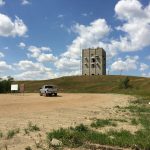
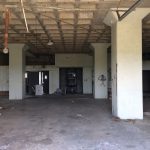
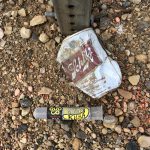
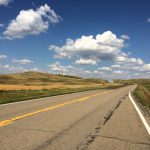
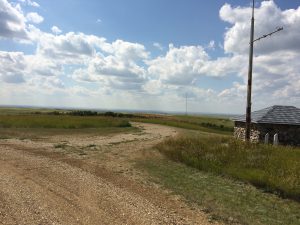
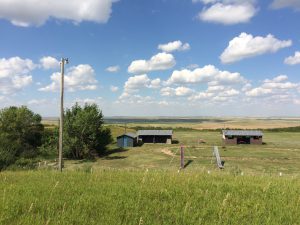
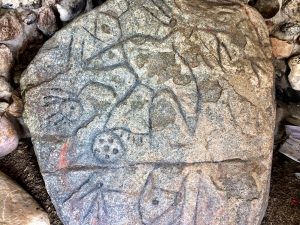
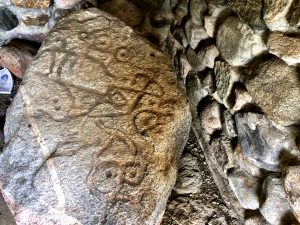
Great adventure! A lot of scrap steel got harvested. Nice video about earlier explorations, tho scary to climb those rusty stairs. What a community it must have been. Wonder how the airmen and their families felt about being posted there. All that time, watching the radar screens, nothing happening. (well, maybe a flock of geese)
How big are those petroglyph stones? Did you slide down the slides in your solitude? Bet they get hot on a sunny day.
Don’t know if I ever told you this, but my Dad’s brother Neal, after a failed lumber yard and construction business in San Luis Obispo post WWII, hired on as a civilian contractor with the military up around Tacoma, WA. I regret that I don’t know many of the details, but he was involved in the selection & purchase of the land on which missile silo’s were constructed all along the northern tier, including North Dakota, and may have been involved in their design and construction. He ultimately settled in Grand Forks, ND. In my Dad’s family, for lack of a better term, there is an engineering gene, and Neal got the Lions share, as did his father, and grandfather. None of the three ever got beyond high school, yet, when in the Army, Neal outscored men in batteries of engineering tests that had graduated colleges such as M.I.T. , and my father and grandfather built railroad bridges between mountains in Arkansas with no visible supports that Engineering students at the University of Arkansas still study and try and figure out, today. Unfortunately, he passed away a few years ago, or I would have sent you to talk to him while on your journey.
I remember you telling me about the bridges, but not the silos. It’s a shame he is gone – I would have loved to talk to one of Rex’s many siblings. 🙂
another fantastic read, Gowan, you make me feel like I am there, thank you
The larger of the two Writing Rocks is about the size of a wheelbarrow, the smaller maybe 2/3 of that. Glad you’re enjoying the trip so far!
Hey Uncle Gowan! To find your blog I accidently tried searching “Uncle Gowan” and then I realized. “That won’t work.” What’s the next stop on your trip?
😀 Hey there buddy! I’m now in Eastern Washington state, soon to move to the Columbia River in couple days. Eventually I will make it to the Pacific Ocean before starting back East. Have no fear; I will be back in Georgia in time to cook you something for Thanksgiving. Thanks for checking out my travelogue!
Hey Uncle Gowan! We just got your card for the Grand Forks Air Force Base and the MAF and I find it really interesting. I want to see what’s inside.
Look at this post: https://www.fenley.net/2018/08/15/nuclear-north-dakota/
I took some pictures in the underground capsules.
My father Rev. Arthur Bohlmann was called to establish LCMS Lutheran churches in the 4 or 5 communities surrounding Fortuna from June 1928 to late 1929 … I have some pictures including his first confirmation class there … and his car by the train tracks a short distance from my parents house, outhouse and hand pump… Mail was delivered by a bag hook from the train … my oldest sibling would have been born there but lack of medical services led my mother to return to her home in St Louis in June 1929… originally they had no cooking stove just a one surface top on a wood stove … their first purchase was a coal stove from Sears that was delivered with a rare full stop of the train.
Thanks for stopping by and leaving your comment, Mark! I love preserving the stories of the people who forged their lives in these tiny towns like Fortuna. Check out my new comment on the Fortuna 2 post for more recent info about this last town in the NW corner of North Dakota.